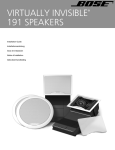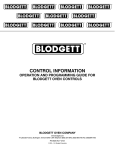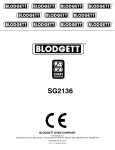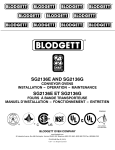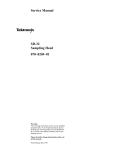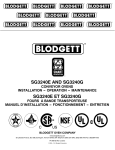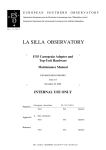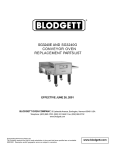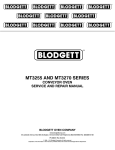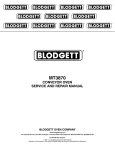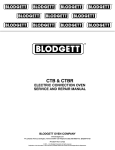Download Blodgett SG2136 E & G Repair manual
Transcript
SMART GENERATION CONVEYOR OVEN SERIES SERVICE AND REPAIR MANUAL BLODGETT OVEN COMPANY www.blodgett.com 50 Lakeside Avenue, Box 586, Burlington, Vermont 05402 USA Telephone, (802) 658Ć6600 Fax: (802)864Ć0183 PN M10306 Rev C (11/01) E 2001 - G.S. Blodgett Corporation TABLE OF CONTENTS This page intentionally left blank. ii TABLE OF CONTENTS 1. INTRODUCTION Oven Specifications . . . . . . . . . . . . . . . . . . . . . . . . . . . . . . . . . . . . . . . . . . . . . . . . . . . . . . . . . . . . . . . Ventilation Requirements . . . . . . . . . . . . . . . . . . . . . . . . . . . . . . . . . . . . . . . . . . . . . . . . . . . . . . . Electrical Specifications . . . . . . . . . . . . . . . . . . . . . . . . . . . . . . . . . . . . . . . . . . . . . . . . . . . . . . . . Gas Specifications . . . . . . . . . . . . . . . . . . . . . . . . . . . . . . . . . . . . . . . . . . . . . . . . . . . . . . . . . . . . 1-1 1-1 1-4 1-6 2. OPERATION Standard Manual Control . . . . . . . . . . . . . . . . . . . . . . . . . . . . . . . . . . . . . . . . . . . . . . . . . . . . . . . . . . Programmable Menu Control . . . . . . . . . . . . . . . . . . . . . . . . . . . . . . . . . . . . . . . . . . . . . . . . . . . . . . Oven Adjustments for Cooking . . . . . . . . . . . . . . . . . . . . . . . . . . . . . . . . . . . . . . . . . . . . . . . . . . . . . Schematics . . . . . . . . . . . . . . . . . . . . . . . . . . . . . . . . . . . . . . . . . . . . . . . . . . . . . . . . . . . . . . . . . . . . . . SG2136G . . . . . . . . . . . . . . . . . . . . . . . . . . . . . . . . . . . . . . . . . . . . . . . . . . . . . . . . . . . . . . . . . . . . SG2136E - 2 Wire . . . . . . . . . . . . . . . . . . . . . . . . . . . . . . . . . . . . . . . . . . . . . . . . . . . . . . . . . . . . SG2136E - 3 Wire . . . . . . . . . . . . . . . . . . . . . . . . . . . . . . . . . . . . . . . . . . . . . . . . . . . . . . . . . . . . SG2136E - 4 Wire . . . . . . . . . . . . . . . . . . . . . . . . . . . . . . . . . . . . . . . . . . . . . . . . . . . . . . . . . . . . SG3240G . . . . . . . . . . . . . . . . . . . . . . . . . . . . . . . . . . . . . . . . . . . . . . . . . . . . . . . . . . . . . . . . . . . . SG3240E - 3 Wire . . . . . . . . . . . . . . . . . . . . . . . . . . . . . . . . . . . . . . . . . . . . . . . . . . . . . . . . . . . . SG3240E - 4 Wire . . . . . . . . . . . . . . . . . . . . . . . . . . . . . . . . . . . . . . . . . . . . . . . . . . . . . . . . . . . . 2-1 2-3 2-5 2-8 2-8 2-9 2-10 2-11 2-12 2-13 2-14 3. CALIBRATION AND ADJUSTMENT Control Identification and Registration . . . . . . . . . . . . . . . . . . . . . . . . . . . . . . . . . . . . . . . . . . . . . . . Gas Pressure Adjustments . . . . . . . . . . . . . . . . . . . . . . . . . . . . . . . . . . . . . . . . . . . . . . . . . . . . . . . . . Convection Blowers . . . . . . . . . . . . . . . . . . . . . . . . . . . . . . . . . . . . . . . . . . . . . . . . . . . . . . . . . . . . . . . Temperature Calibration . . . . . . . . . . . . . . . . . . . . . . . . . . . . . . . . . . . . . . . . . . . . . . . . . . . . . . . . . . . Belt Speed Calibration . . . . . . . . . . . . . . . . . . . . . . . . . . . . . . . . . . . . . . . . . . . . . . . . . . . . . . . . . . . . 3-1 3-2 3-5 3-6 3-8 4. PARTS REPLACEMENT PLC Replacement and Programming . . . . . . . . . . . . . . . . . . . . . . . . . . . . . . . . . . . . . . . . . . . . . . . . Interface Board . . . . . . . . . . . . . . . . . . . . . . . . . . . . . . . . . . . . . . . . . . . . . . . . . . . . . . . . . . . . . . . . . . . Circulating Fan Pressure Switch . . . . . . . . . . . . . . . . . . . . . . . . . . . . . . . . . . . . . . . . . . . . . . . . . . . . Combustion Pressure Switch Adjustment . . . . . . . . . . . . . . . . . . . . . . . . . . . . . . . . . . . . . . . . . . . . 4-1 4-2 4-3 4-5 5. TROUBLESHOOTING Fault Display Indicators . . . . . . . . . . . . . . . . . . . . . . . . . . . . . . . . . . . . . . . . . . . . . . . . . . . . . . . . . . . . DC Drive System . . . . . . . . . . . . . . . . . . . . . . . . . . . . . . . . . . . . . . . . . . . . . . . . . . . . . . . . . . . . . . . . . Heating System . . . . . . . . . . . . . . . . . . . . . . . . . . . . . . . . . . . . . . . . . . . . . . . . . . . . . . . . . . . . . . . . . . Convection System . . . . . . . . . . . . . . . . . . . . . . . . . . . . . . . . . . . . . . . . . . . . . . . . . . . . . . . . . . . . . . . Reference Tables . . . . . . . . . . . . . . . . . . . . . . . . . . . . . . . . . . . . . . . . . . . . . . . . . . . . . . . . . . . . . . . . . Heating Element Resistance . . . . . . . . . . . . . . . . . . . . . . . . . . . . . . . . . . . . . . . . . . . . . . . . . . . . Probe Resistance vs Temperature . . . . . . . . . . . . . . . . . . . . . . . . . . . . . . . . . . . . . . . . . . . . . . . 5-1 5-2 5-3 5-7 5-8 5-8 5-8 i TABLE OF CONTENTS This page intentionally left blank. ii CHAPTER 1 INTRODUCTION SMART GENERATION OVEN SPECIFICATIONS VENTILATION REQUIREMENTS inĆline tempering unit. Air supplied directly from outĆ side the building to the kitchen or oven area, nonĆ tempered, can be used as supply air but the design must accommodate potential operational and enviĆ ronmental drawbacks. A mechanically driven ventilation system is reĆ quired for the removal of excess heat and cooking vapors. For gas models, a ventilation system is also required for the removal of the products of gas combustion. The necessity for a properly designed and installed ventilation system cannot be over emphasized. NOTE: In NO case should supply air blow at or near the cooking chamber openings as that would adversely affect the cooking consistency and the reliability of the oven. The following are general recommendations and guidelines for good ventilation. Your specific apĆ plication may require the services of a ventilation engineer or consultant The hood should be sized to completely cover the equipment plus an overhang of at least 6" (15cm) on all sides not adjacent to a wall. The distance from the floor to the lower edge of the hood should not exceed 7' (2.1m). See FIGURE 2. The ventilation hood must work well with the building heating, ventilation and air conditioning (HVAC) sysĆ tem. The hood exhaust and the supply air flows should be sized appropriately. Supply air must be provided by either the hood system or the building HVAC system in order to prevent a negative presĆ sure in the oven area. Supply air should replace approximately 80% of the air flow exhausted by the hood. The table below can be used as a guideline, but the correct air flow values depend on the effiĆ ciency of the hood design, the amount of air flow around the oven, and the current air flow in and out of the kitchen or oven area (for existing facilities). MODEL SINGLE DOUBLE U.S. and Canadian installations Refer to your local ventilation codes. Requirements may vary by city, county, province or state. In the absence of local codes, refer to the National venĆ tilation code titled, Standard for the Installation of Equipment for the Removal of Smoke and Grease Laden Vapors from Commercial Cooking EquipĆ ment", NFPAĆ96ĆLatest Edition. General export installations Installation must conform with Local and National installation standards. Local installation codes and/or requirements may vary. If you have any questions regarding the proper installation and/or operation of your Blodgett oven, please contact your local distributor. If you do not have a local disĆ tributor, please call the Blodgett Oven Company at 0011Ć802Ć860Ć3700. TRIPLE Exhaust Volume - CFM (M3/min) SG2136 400Ć500 (14Ć17) 800Ć1000 (23Ć28) 1200Ć150 0 (34Ć43) SG3240 800Ć1000 (23Ć28) 1200Ć1600 (34Ć46) 2000Ć240 0 (57Ć68) Supply Requirements - CFM (M3/min) SG2136 320Ć400 (12Ć14) 640Ć800 (18Ć23) 960Ć1200 (27Ć34) SG3240 640Ć800 (18Ć23) 960Ć1280 (27Ć36) 1600Ć192 0 (46Ć54) WARNING: Failure to properly vent the oven can be hazardĆ ous to the health of the operator and may result in operational problems, unsatisfactory baking and possible damage to the equipment. Damage sustained as a direct result of improper ventilation will not be covered by the ManufacturĆ er's warranty. TABLE 1 Ideally, supply air is provided through the building HVAC system or, secondly, through the hood with an 1-1 6" (15.2 cm) Minimum FIGURE 1 1-2 9" (22.7 cm) 20" (50.8 cm) 60" (152.4 cm) 6" (15 .2cm) Minimum Triple Stack - 6.5" (17 cm) Double Stack - 17.5" (44.5 cm) Single Stack - 23.5" (59.7 cm) SG2136 Series Shown 64" (162.5 cm) 3" (7.6 cm) Minimum 0" (0cm) if wall or 6" (15.2 cm) INTRODUCTION 6" (15.2 cm) Minimum 77" (196 cm) SG3240 Series Shown 3" (7.6 cm) Minimum FIGURE 2 1-3 Triple Stack - 7" (17.8 cm) Double Stack - 17.25" (43.8 cm) Single Stack - 23.25" (59 cm) 14" (35.5 cm) 24" (61 cm) 72" (182 cm) 6" (15 .2cm) Minimum 0" (0cm) if wall or 6" (15.2 cm) SMART GENERATION INTRODUCTION ELECTRICAL SPECIFICATIONS SG2136G SG3240G The SG2136G requires a 5 Amp, 50/60HZ, 1, 208Ć240VAC, 3 wire service consisting of L1, L2 and ground. Use 75_C rated cable. Size wire to NaĆ tional Electric or local codes. The SG3240G requires a 5 Amp, 50/60HZ, 1, 208Ć240VAC, 3 wire service consisting of L1, L2 and ground. Wiring from the power source to these units must be a minimum of #16 AWG CU. stranded wire or larger. SG2136E SG3240E Use 75_C rated cable. Size wire to National Electric or local codes. Use 90_C rated cable. Size wire to National Electric or local codes. The SG2136E is available in 6 electrical configuraĆ tions. The SG3240E is available in 4 electrical configurations. U.S. and Canadian installations (or similar) U.S. and Canadian installations (or similar) D 76 amp, 60 HZ, 1, 208 VAC, 2 wire service consisting of L1, L2, and ground. D 69 amp, 50/60 HZ, 3, 208 VAC, 4 wire service consisting of L1, L2, L3, and ground. D 66 amp, 60 HZ, 1, 240 VAC, 2 wire service consisting of L1, L2, and ground. D 80 amp, 50/60 HZ, 3, 240 VAC, 4 wire service consisting of L1, L2, L3, and ground. D 44 amp, 60 HZ, 3, 208 VAC, 3 wire service consisting of L1, L2, L3 and ground. General export installations D 38 amp, 60 HZ, 3, 240 VAC, 3 wire service consisting of L1, L2, L3 and ground. General export installations D D 24 amp, 50/60 HZ, 3 WYE, 220/380 VAC, 4 wire service consisting of L1, L2, L3, neutral and ground. D 41.5 amp, 50/60 HZ, 3 WYE, 230/400 VAC, 4 wire service consisting of L1, L2, L3, neutral and ground. D 40 amp, 50/60 HZ, 3 WYE, 240/415 VAC, 4 wire service consisting of L1, L2, L3, neutral and ground. THE BLODGETT CANNOT ASSUME RESPONSIĆ BILITY FOR LOSS OR DAMAGE SUFFERED AS A RESULT OF IMPROPER INSTALLATION. 23 amp, 50/60 HZ, 3 WYE, 240/415 VAC, 4 wire service consisting of L1, L2, L3, neutral and ground. WARNING!! Incorrect single phase wiring may result in exĆ tensive damage to electrical components and fire in the electrical box. 1-4 SMART GENERATION SG2136E Single Phase Power SG2136G and SG3240G L1 Supply L2 L1 208Ć240 Oven Supply Supply L2 L3 208Ć240 Oven SG2136E and SG3240E Wye Three Phase Power General Export Installations SG2136E and SG3240E Delta Three Phase Power U.S. and Canadian Installations (or similar) L1 L2 208 or 240 (typical) 400/ 415 L1 Oven Supply L2 400/415 L3 400/415 N FIGURE 3 1-5 230/ 240 Oven INTRODUCTION GAS SPECIFICATIONS GAS CONNECTIONS NOTE: For natural gas meter sizing, consult your local gas company to ensure that your meĆ ter will provide the proper supply. Domestic and General Export installations The gas line should be large enough to accommoĆ date the peak demand of all the gas appliances. TABLE 2 reflects a straight line, 50 foot run with no coupling restrictions and no other appliances drawing service. Gas line installations MUST conĆ form to National Fuel Gas Code NFPA 54/ANSI Z223.1 Sec. 1.4 (Latest Edition). TABLE 2 should be used as a guideline only. Installations within the U.S. 1. Add the total BTU's/hr of all the gas appliances. 2. Convert BTU's to cubic ft/hr using the formula Cu Ft/Hr = 1000 BTU/Hr for natural gas. 3. Size the meter accordingly. Installations outside the U.S. NOTE: For any pipe runs over 50 feet (15 m), conĆ sult the factory. 1. Add the total M3/min of all the appliances. 2. Size the meter accordingly. GAS REQUIREMENTS The firing rate for the SG3240G is 110,000 BTU/hr (32.2 kW/hr) (116 MJ/hr). The firing rate for the SG2136G is 60,000 BTU/hr (17.6KW) (63 MJ/hr). SG2136G DOMESTIC AND GENERAL EXPORT Natural Gas Propane Gas Single 3/4" line 3/4" line Double 3/4" line 3/4" line Triple 1" line 3/4" line Orifice Size 3.45mm (0.136") diameter 2.08mm (0.082") diameter Gas Line Sizing Incoming Gas Pressure W.C. kPa mbar W.C. kPa mbar 7" 1.74 17.4 12.5" 3.11 31.1 5.5" 1.36 13.7 11" 2.73 27.4 3.5" 0.87 8.7 10" 2.50 25.0 Static Operational Manifold Burner Pressure SG2136G CE APPROVED UNITS Type of Gas Inlet Pressure mbars Burner Pressure mbars Injector Diameter mm Air Opening mm Pilot Injector mm Standard Delivery Value kW (HS) G25 25 13 3,45 5,1 2 x 0,63 17,6 Nat. Gas G20 20 8.7 3,45 5,1 2 x 0,63 17,6 Nat. Gas G20/G25 20/25 Totally Inscrewed Pressure Regulator 3,45 plus preĆinjector 5,1 2 x 0,63 17,6 Nat. Gas G30 30/50 20 2,08 5,1 2 x 0,30 17,6 Butane G31 30/37/50 25 2,08 5,1 2 x 0,30 17,6 Propane TABLE 2 1-6 SMART GENERATION SG3240G DOMESTIC AND GENERAL EXPORT Natural Gas Propane Gas Single 3/4" line 3/4" line Double 1Ć1/4" line 1" line Triple 1Ć1/4" line 1Ć1/4" line Orifice Size 4.80mm (0.189") diameter 2.82mm (0.111") diameter Gas Line Sizing Incoming Gas Pressure W.C. kPa mbar W.C. kPa mbar 7" 1.74 17.4 12.5" 3.11 31.1 5.5" 1.36 13.7 11" 2.73 27.4 3.5" 0.87 8.7 10" 2.50 25.0 Static Operational Manifold Burner Pressure SG3240G CE APPROVED UNITS Type of Gas Inlet Pressure mbars Burner Pressure mbars Injector Diameter mm Air Opening mm Pilot Injector mm Standard Delivery Value kW (HS) G25 25 13.5 4,8 10 2 x 0,63 32,2 Nat. Gas G20 20 8.7 4,8 10 2 x 0,63 32,2 Nat. Gas G20/G25 20/25 Totally Inscrewed Pressure Regulator 4,8 plus preĆinjector 10 2 x 0,63 32,2 Nat. Gas G30 30/50 20 2,8 10 2 x 0,30 32,2 Butane G31 30/37/50 25 2,8 10 2 x 0,30 32,2 Propane TABLE 3 1-7 INTRODUCTION This page intentionally left blank. 1-8 CHAPTER 2 OPERATION SMART GENERATION STANDARD MANUAL CONTROL MANUAL CONTROL DESCRIPTION 1. DIGITAL DISPLAY - two line display gives the time, temperature and other control related inĆ formation. 4. ARROW KEYS - press to change the set time and temperature in the display. 5. TIME KEY - press to change the cook time. 2. OVEN ON/OFF (ON/STANDBY) - controls power to the oven. 6. ENTER/RESET KEY - press to save new cook time or temperature. Also press to silence the alarm in case of a fault. The alarm will sound every ten seconds until the fault clears. 3. TEMPERATURE KEY - press to change the cook temperature. 1 2 6 3 4 FIGURE 1 2-1 5 OPERATION OPERATION To change the cook time: NOTE: The following example is in _F. The display will read _C if programmed in celsius. 1. Press the TIME key (5). To turn the oven on: The display reads: 1. Press the OVEN ON/OFF key (2). The control defaults to the last time and temperature setĆ tings used. The display reads: 2. Press the ARROW keys (4) to scroll to the deĆ sired cook time. SET TEMP XXXF HEAT COOK TIME XX:XX 3. Press the ENTER key (6) to set the new cook time. NOTE: HEAT appears in the top line of the disĆ play whenever the control calls for heat. To display the actual oven temperature: 1. Press both ARROW keys (4) . 2. The fans begin to run. The conveyor belt beĆ gins to travel at the set cook time. The heat rises to the setpoint temperature. The display reads: 3. When the oven reaches the set temperature, READY and SET TEMP flash alternately in the top line of the display and an audible alarm sounds. TEMP XXXF DOWN - EXIT 2. Press the down arrow key to return the display to the setpoint time and temperature. To turn the oven off: To change the cook temperature: 1. Press the OVEN ON/OFF key (2). The oven is equipped with a coolĆdown feature for motor shaft and bearing protection. This enables the blower motor(s) to run regardless of the conĆ troller status. The blower(s) continue to run unĆ til the oven cools to a safe temperature. 1. Press the TEMPERATURE key (3). The display reads: SET COOK TIME XX:XX SET POINT TEMP XXXF 2. Press the ARROW keys (4) to scroll to the deĆ sired cook temperature. This oven, supplied with remote control, is equipped with an emergency shut down switch. Should you need to stop the belt, fans, or heat press the emergency switch. 3. Press the ENTER key (6) to set the new cook temperature. Do not use the emergency switch as a GENERAL on/off switch! 2-2 SMART GENERATION PROGRAMMABLE MENU CONTROL MENU CONTROL DESCRIPTION 1. DIGITAL DISPLAY - two line display gives the time, temperature and other control related inĆ formation. 4. MENU KEYS - programmable product keys. Up to four different time and temperature setĆ tings can be saved. 2. OVEN ON/OFF (ON/STANDBY) - controls power to the oven. 5. ENTER/RESET KEY - press to save settings while programming. Also press to silence the alarm in case of a fault. The alarm will sound every ten seconds until the fault clears. 3. ARROW KEYS - press to change the time and temperature in the display. Also press to scroll through menus during programming. 1 2 3 5 4 FIGURE 2 2-3 OPERATION MENU PROGRAMMING OPERATION NOTE: The following example is in _F. The display will read _C if programmed in celsius. 1. Press the OVEN ON/OFF key (2). The control defaults to the last time and temperature setĆ tings used. To enter programming mode: 1. With the oven off, press and hold the UP ARĆ ROW key (3) and the ENTER/RESET key (5) siĆ multaneously for approximately three seconds. The display reads: The display reads: ACCESS CODE 000 NOTE: HEAT appears in the top line of the disĆ play whenever the control calls for heat. 2. Press and hold the UP ARROW key (3) until the bottom line of the display reads 111 (the store access code). 2. Press the desired MENU key (4). 3. The fans begin to run. The conveyor belt beĆ gins to travel at the set cook time. The heat rises to the setpoint temperature. 3. Press the ENTER/RESET key (5) to enter the programming mode. 4. When the oven reaches the set temperature, READY and SET are displayed. The heat rises to the setpoint temperature. TEMP flash alterĆ nately in the top line of the display and an audiĆ ble alarm sounds. To program the menu keys: 1. The display reads: SELECT MENU KEY MENU 1, 2, 3, OR 4 NOTE: To change the cook time and temperaĆ ture press any of the other menu keys. 2. Press the MENU key (4) to be programmed. NOTE: For this example we will program menu key 1. 3. The display reads: To display the actual oven temperature: 1. Press both ARROW keys (4) . MENUĆ1 SELECT TEMP XXXF PRESS ENTER The display reads: Use the ARROW keys (3) to scroll to the deĆ sired cook temperature. Press the ENTER key (5) to store the new cook temperature. 4. The display reads: XXXF DOWN - EXIT 2. Press the down arrow key to return the display to the setpoint time and temperature. To turn the oven off: MENUĆ1 COOK TIME XX:XX PRESS ENTER 1. Press the OVEN ON/OFF key (2). The oven is equipped with a coolĆdown feature for motor shaft and bearing protection. This enables the blower motor(s) to run regardless of the conĆ troller status. The blower(s) continue to run unĆ til the oven cools to a safe temperature. Use the ARROW keys (3) to scroll to the deĆ sired cook time. Press the ENTER key (5) to store the new cook time. 5. The display flashes: MĆX TEMP XXXF HEAT COOK TIME XX:XX MENUĆ1 PROGRAM DONE This oven, supplied with remote control, is equipped with an emergency shut down switch. Should you need to stop the belt, fans, or heat press the emergency switch. To exit the programming mode: 1. Press and hold the UP ARROW key (3) and the ENTER/RESET key (5) simultaneously for approximately three seconds. Do not use the emergency switch as a GENERAL on/off switch! NOTE: If no key is pressed for 60 seconds, the control automatically exits the program mode. 2-4 SMART GENERATION OVEN ADJUSTMENTS FOR COOKING The combination of belt time, oven temperature, and air flow are important for achieving quality reĆ sults from your Blodgett conveyor oven. Use the following guidelines to adjust the belt time and oven temperature of your unit. For questions reĆ garding further oven adjustments, please contact your local Blodgett Sales Representative for assisĆ tance. Air flow adjustments may be necessary to fine tune the oven for your particular product. The air plate, located at the top of the baking chamber, contains holes that can be covered using BlockĆoff Plates. The plates can easily be adjusted to regulate the air flow for your particular needs. Use the following guidelines to adjust the BlockĆoff Plates. See FIGURE 4. CONVEYOR SPEED AND OVEN TEMPERATURE 1. Ensure the oven is Off and completely cooled. 2. Open the front access door. Conveyor belt speed (cook time) and oven temperĆ ature are the two variables used when fine tuning your oven for a specific product. To determine the optimum bake time and temperature, make small changes for each trial and keep one variable constant. For example, if the oven temperature is 460_F (238_C) and the belt speed is 7 minutes, but the pizza is not browned enough, increase the temĆ perature to 475_F (246_C) and keep the belt speed the same. However, if the center of the pizza is not completely cooked, keep the oven temperature the same, and increase the bake time to 7 minutes and 30 seconds. In general, raise the bake temperĆ ature to increase browning, and lengthen the belt time to increase doneness. 3. Using the supplied air plate hook, pull the air plate out of the oven. 4. Remove the wing nuts, screws, and washers holding the BlockĆoff Plates. 5. Adjust the plates. 6. Replace the wing nuts, screws, and washers to tightly secure the BlockĆoff plates in their new locations. Make a sketch of the final airĆ plate setup for future reference. NOTE: One or two blockĆoff plates may be left off entirely if appropriate to obtain the desired results. 7. Replace the air plate. FINISHED PRODUCT TEMPERATURES 8. Close the front access door. Internal temperatures of the cooked products should be measured immediately after the product exits the cooking chamber to ensure a safe food temperature. Internal pizza temperatures should be over 165_F (74_C). Minimum temperature guideĆ lines vary depending on the food items. The following examples illustrate air flow regulation. NOTE: The first half of the oven chamber greatly afĆ fects the initial baking of the product, while the last half largely affects the browning. D A good bake time and temperature have been established, but more top browning is desired. Slide one of the BlockĆoff Plates to uncover a row of holes toward the exit end of the oven. D The bottom of the pizza is golden brown, but the top is too dark. Close rows at the exit end of the oven to reduce final browning. D The center of the pizza is still doughy and the toppings are not fully cooked. Open up rows at the chamber entrance and close rows at the chamber exit. AIR FLOW ADJUSTMENTS Slide the product clearance adjustment plates to the lowest possible setting for your menu items. Lowering the clearance plates will reduce the amount of hot air escaping from the chamber openings. 2-5 OPERATION Air Slides BlockĆOff Plate Air Flow Plate Air Flow Plates SG2136 Series Shown FIGURE 3 Product Clearance Adjustment Plate BlockĆOff Plate Air Flow Plate SG3240 Series Shown FIGURE 4 2-6 SMART GENERATION SCHEMATICS SG2136G FIGURE 5 2-7 OPERATION SG2136E - 2 WIRE FIGURE 6 2-8 SMART GENERATION SG2136E - 3 WIRE FIGURE 7 2-9 OPERATION SG2136E - 4 WIRE FIGURE 8 2-10 SMART GENERATION SG3240G FIGURE 9 2-11 OPERATION SG3240E - 3 WIRE FIGURE 10 2-12 SMART GENERATION SG3240E - 4 WIRE FIGURE 11 2-13 CHAPTER 3 CALIBRATION AND ADJUSTMENT SMART GENERATION CONTROL IDENTIFICATION AND REGISTRATION CONTROL REGISTRATION The following instructions are for both the standard manual and programmable menu PLC controls. See FIGURE 12 for control identification. NOTE: The following control registration proceĆ dure applies to installations in North AmeriĆ ca only. The installer may be required to obtain a registration number from the Blodgett Oven Service Department before the unit can be operated. Use the following procedure for control registration: 1. Registration is required if after applying power to the oven for the first time the display reads: CALL SRVC FOR REG # 1Ć800Ć331Ć5842 2. Note the serial number of the oven and call Blodgett Oven Service at the number shown on the display to obtain your registration number. Standard Manual PLC Control 3. Press the ENTER/RESET key. 4. The display reads: REG # XXXX Use the arrow keys to scroll to the registration number for your unit. Press the ENTER/RESET key to enter the registration number. 5. The display reads: OVEN OFF 6. The oven can now be turned on. VENTILATION Menu Programmable PLC Control Ignite a smoke candle inside the oven cavity. Note the amount of smoke removed by the ventilation system. The recommended amount of smoke to be removed is 90-100%. FIGURE 12 3-1 CALIBRATION AND ADJUSTMENT GAS PRESSURE ADJUSTMENTS REGULATED GAS PRESSURE NOTE: Gas models only. The incoming and manifold pressure should be meaĆ sured at the same time with two water manometers. The oven must be turned on and the main burner valve open. This method will reveal any obstructions in the pipe line or inadequate pipe size. 1. Let the oven heat to 510_F (266_C). 2. Check the pressure at the tap on the multiĆfuncĆ tion gas valve or at the tap on the tee fitting at the rear of the electrical box. See FIGURE 13. To adjust the manifold pressure Incoming gas pressure to the unit, with all the gas appliances drawing from the supply, should be a minimum of 5.5" W.C. (13.7 mbar) for natural gas and 11" W.C. (27.4 mbar) for propane gas. This measurement should be taken at the Incoming Line Pressure Tap. The maximum pressure should not exceed 13" W.C. (32.3 mbar). 1. Unscrew the regulator adjustment cover cap. 2. Turn the adjusting screw inside the gas valve. NOTE: Turn the screw clockwise to raise the manifold pressure and counterĆclockĆ wise to lower it. 3. Reinstall the cover cap. NOTE: For installations using GĆ20/GĆ25 gas, the regulator must be completely screwed in. NOTE: The cover cap acts as a flow limiter, in the event of a diaphragm rupture it will limit the flow of gas into the building. The manifold pressure must be 3.5" W.C. (8.7 mbar) for natural gas and 10" W.C. (25 mbar) for propane gas. This measurement should be taken at the Manifold and Pilot Pressure Tap. Incoming Line Pressure Tap* Regulator Adjustment Cover Cap Water Manometer Regulator Adjustment Screw (inside) Manifold and Pilot Pressure Tap* Water Manometer * Pipe plug used in US/Canadian ovens FIGURE 13 3-2 SMART GENERATION PRIMARY AIR ADJUSTMENT COMBUSTION BLOWER PRESSURE SWITCH ADJUSTMENT NOTE: Gas models only. The adjustment of the pressure switches after installation is extremely important. The switch proves that the gas combustion air blower is operaĆ tional. If the pressure switch stays open, the oven will not heat. The operator will be given both audiĆ ble and visual alarms for a combustion blower failĆ ure: COMBUSTION BLWR FAIL" The air shutter disc on the burner blower motor, loĆ cated inside the control box at the top of the asĆ sembly, is factory adjusted to provide the most effiĆ cient blue flame possible at sea level. 1. Visually examine the quality of the flame. 2. If it needs adjusting, increase or decrease the air mixture to attain the best flame quality. Be sure to tighten the lock nut when finished. If the switch is adjusted too sensitively (- clockĆ wise), it will not open when the combustion blower is turned off. In this case, when the oven is turned on again, the control system would see the presĆ sure switch as stuck closed." The oven will not heat, and the operator will be given both audible and visual alarms indicating combustion pressure switch failure: COMB PS FAILURE." 3. If the combustion blower alarm is actuated, the combustion pressure switch may need to be readjusted. The adjustment screw is visible on the top of the pressure switch. NOTE: The pressure switch is located on the ignition control board on the pull out tray at the bottom of the electrical box. 1. With the oven OFF and the combustion blower OFF (it'll shut off 20 seconds after turning the oven off), turn the adjustment screw clockwise (-) just until the pressure switch closes (indiĆ cated when the LED marked COMB PS" is illuĆ minated on the control tray). 2. Slowly turn the adjustment screw counterclockwise approximately (+) 1/4 turn PAST the point where the switch opens (LED shuts off). 3. Turn the oven ON. 4. Place your hand over the circular air shutter on the combustion blower. Close off part of the air opening with your hand and fingers. NOTE: Adjust the switch to close only when the combustion fan is operating either with very little or no restriction 5. If the switch is adjusted properly, an audible alarm sounds and a fault appears in the disĆ play indicating a combustion blower failure: COMBUSTION BLWR FAIL." If so, no further adjustment is necessary. If there is no alarm, the pressure switch needs adjustment as folĆ lows: A.) Turn the adjustment screw counterclockwise (+) another 1/4 turn and test again if it will close easily by blocking it with your hand. This allows the pressure switch to open more easily. 3-3 CALIBRATION AND ADJUSTMENT Circulation Blowers' Pressure Switch (See View D) Blower 2 Relay View B SW4 Blower 1 Relay ENB 2 DIR 2 ENB 1 DIR 1 Switch 4 (See View B) Heat Relay Ignition Control Board (See View C) Interface Board (See View A) Interface Board - View A Combustion Blower Pressure Switch (See View D) Interface Slide Tray (SG3240G shown) Typical circulation blower pressure expected is .30" W.C. (SG3240) or .25" W.C. (SG2136) Ignition Control Board - View C Adjustment Screw + - High Side Port (Internal Snubber) Connect Pressure Hose here Pressure Switch - View D FIGURE 14 3-4 SMART GENERATION CONVECTION BLOWERS MOTOR ROTATION OF CONVECTION BLOWERS CHECKING THE LOW LIMIT OF THE BLOWERS: The correct amp draw for most gas conveyor ovens is 1 amp when the oven is hot. 1. Turn the oven on. Let it heat to 200_F (93_C). Shut the oven off. The blowers should come back on in several seconds. If the amp draw is less than .5, remove the back of the oven and check for proper motor rotation direcĆ tion. See FIGURE 15. NOTE: Open the small front access door to speed cooling. Due to its vertical positioning the motor direction is reference from the end of the motor (EOM) as viewed from the rear of the oven. NOTE: To view actual temperature, press the arrow keys simultaneously. To return to normal display operation, press the down arrow key. 2. When the blowers shut off, turn the oven on. Press both arrow keys to display the actual temperature and verify that the blowers shut off between 135_F and 170_F (57Ć77_C). Blower Motor Motor #1 (Side view) (Top view) FIGURE 15 3-5 Motor #2 Control Box SG3240 BLOWER WHEEL ROTATION Slinger Cooling Fan CALIBRATION AND ADJUSTMENT TEMPERATURE CALIBRATION To Calibrate the Cook Temperature: After the oven has been cycling at the normal temĆ perature for 60 minutes, place a temperature probe in the center of the oven to verify proper caliĆ bration. If the oven is not cycling to within 5_F (3_C) of the setpoint use the following calibration procedure. 1. The display reads: Use the arrow keys to toggle between TEMP and TIME. When the display reads TEMP, press the ENTER/RESET key. To Enter Configuration and Calibration Mode: 1. With the oven off, press and hold the UP ARĆ ROW key and the ENTER/RESET key simultaĆ neously for approximately three seconds. The display reads: NOTE: The control will stay in the calibration mode until the UP ARROW and the ENĆ TER/RESET keys are pressed simultaĆ neously for about three seconds. ACCESS CODE 000 2. The oven continues to operate; however, the conveyor does not move. 2. To enter the service level access menu, press and hold the UP ARROW key until the bottom line of the display reads 331. 3. The display reads: NOTE: If no key is pressed within 60 seconds or if the UP ARROW and ENTER/RESET keys are pressed simultaneously for about three seconds, the display will return to the previous mode. SELECT TEMP MODE DEGREES X Use the arrow keys to toggle between_ F and_ C. Press the ENTER/RESET key to select the deĆ sired temperature units. 4. The display reads: 3. Press the ENTER/RESET key to enter the ConĆ figuration and Calibration mode. 4. The display reads: SELECT TEMP/TIME CAL XXXX SELECT CAL SET POINT XXXF Use the arrow keys to scroll to the desired calĆ ibration set point temperature. Press the ENĆ TER/RESET key to select that temperature. SELECT PROGRAM MAN/MENU MODE 5. The display reads: Use either arrow key to scroll through the choices on the bottom line of the display. When the bottom line reads CALIBRATION ROUTINE press the ENTER/RESET key. SET POINT TEMP XXXF CAL PROBE TEMP XXXF NOTE: The temperature in line two of the disĆ play will be flashing. Use the arrow keys to scroll to the actual temĆ perature measured by the probe. Use the averĆ age of the high and low temperatures seen during heat cycling. Press the ENTER/RESET key to enter the probe temperature. 3-6 SMART GENERATION 6. The display reads: To Exit Configuration and Calibration Mode: OVEN TEMP XXXF OFFSET +(-)XXXF 1. Press and hold the UP ARROW and ENTER/ RESET keys simultaneously for approximately three seconds. NOTE: The offset equals the setpoint minus the probe temperature. NOTE: The top line now displays the operating oven temperature including the offset. You can use the arrow keys to fine tune the offĆ set by scrolling to a desired offset value. Press the ENTER/RESET key to accept the offset. 7. The display reads: CALIBRATION DONE? UP-EXIT DOWN-CONT Press the up arrow key to exit the Temperature Calibration mode and return to the service levĆ el menu or press the down arrow key to return to step 3 of the temperature calibration proceĆ dure. 3-7 CALIBRATION AND ADJUSTMENT BELT SPEED CALIBRATION To Calibrate the Belt Speed: Place an object on the belt. Time its passage from entrance to exit. If the actual speed is not within 5 seconds of the set time, check the calibration setĆ tings as follows. 1. The display reads: NOTE: Measure using the leading or the trailing edge. Do not use the leading edge in and the trailing edge out. Use the arrow keys to toggle between TEMP and TIME. When the display reads TIME, press the ENTER/RESET key. To Enter Configuration and Calibration Mode: NOTE: The control will stay in the calibration mode until the UP ARROW and the ENĆ TER/RESET keys are pressed simultaĆ neously for about three seconds. 1. With the oven off, press and hold the UP ARĆ ROW key and the ENTER/RESET key simultaĆ neously for approximately three seconds. The display reads: SELECT TEMP/TIME CAL XXXX 2. The display reads: ACCESS CODE 000 SELECT OVEN LENGTH XX 2. To enter the service level access menu, press and hold the UP ARROW key until the bottom line of the display reads 331. Use the arrow keys to scroll to the proper oven length. Press the ENTER/RESET key to select the correct oven length. NOTE: If no key is pressed within 60 seconds or if the UP ARROW and ENTER/RESET keys are pressed simultaneously for about three seconds, the display will return to the previous mode. NOTE: Refer to the table on the next page for correct calibration values. 3. The display reads: 3. Press the ENTER/RESET key to enter the ConĆ figuration and Calibration mode. 4. The display reads: SELECT SHAFT TEETH XX Use the arrow keys to scroll to the proper numĆ ber of teeth on the conveyor shaft sprocket. Press the ENTER/RESET key to select the corĆ rect number of shaft teeth. SELECT PROGRAM MAN/MENU MODE 4. The display reads: Use either arrow key to scroll through the choices on the bottom line of the display. When the bottom line reads CALIBRATION ROUTINE press the ENTER/RESET key. SELECT MOTOR TEETH XX Use the arrow keys to scroll to the proper numĆ ber of teeth on the motor shaft sprocket. Press the ENTER/RESET key to select the corĆ rect number of motor teeth. 5. The display reads: SELECT BELT RADIUS X.XXXX Use the arrow keys to scroll to the correct belt radius. Press the ENTER/RESET key to select the correct belt radius value. 3-8 SMART GENERATION 6. The display reads: To Exit Calibration Mode: SELECT MOTOR RATIO XX 1. Press and hold the UP ARROW and ENTER/ RESET keys simultaneously for approximately three seconds. Use the arrow keys to scroll to the correct moĆ tor ratio. Press the ENTER/RESET key to select the correct motor ratio value. 7. The display reads: TIME CAL DONE? UP-EXIT DOWN-CONT Press the up arrow key to exit the Belt Speed Calibration Mode and return to the service levĆ el menu, or press the down arrow key to return to step 2 of the belt speed calibration proceĆ dure. Model Oven Length Shaft Teeth Motor Teeth Belt Radius Motor Ratio SG2136 36" 30 30 0.8850 18 SG3240 40" 15 15 0.8850 18 3-9 CHAPTER 4 PARTS REPLACEMENT SMART GENERATION PLC REPLACEMENT AND PROGRAMMING PLC REMOVAL AND REPLACEMENT PLC PROGRAMMING 1. Remove burner and control access cover. 1. With the oven off, press the UP ARROW key and the ENTER/RESET keys simultaneously for approximately 3 to 5 seconds. The display will read ACCESS CODE. 2. Disconnect the ribbon cables. 3. Disconnect power supplies from both the PLC and the RTD converter. 2. To enter the service access level, press and hold the UP ARROW key until the bottom line of the display reads 331. 4. Remove the probe wires from the RTD convertĆ er. 5. Press down on the retaining latches that hold the PLC and the RTD converter to the din rail. 3. After 331 appears in the display, press the ENĆ TER/RESET key. The top line of the display reads SELECT PROGRAM. The bottom line of the display reads MAN/MENU. 6. Separate the PLC and RTD converter from each other. 4. Press the ENTER/RESET key. Use the ARROW keys to select either manual or menu mode. Press the ENTER/RESET key to select your choice. 7. Reverse steps 1-6 to install the new PLC. Ribbon Cable plugs in here 5. Use the ARROW keys to scroll to the twin belt choice. Press the ENTER/RESET key to enter the menu. Use the ARROW keys to select your choice. Display plugs in here 6. Press the ENTER/RESET key. Use the ARROW keys to scroll to the gas or electric choice. Press the ENTER/RESET key to enter the menu. Use the ARROW keys to select your choice. Power Supply plugs in here 7. Press the ENTER/RESET key. Use the ARROW keys to scroll to the calibration mode. Press the ENTER/RESET key to enter the menu. Latch release 8. See page 3-8 Belt Speed Calibation instrucĆ tions. PLC 9. See page 3-6 for Temperature Calibration inĆ structions. RTDs plug in here RTD Converter FIGURE 1 4-1 PARTS REPLACEMENT INTERFACE BOARD NOTE: The interface board is sensitive to electroĆ static discharge. Proper grounding preĆ cautions are required before handling the interface board. BELT DIRECTION NOTE: If motor direction is changed the belt direcĆ tion must also be changed. REMOVAL AND REPLACEMENT 1. Locate the enable/disable switches and direcĆ tion switches on the IFB. 1. Remove the ribbon clable and other harnesses from the board. 2. Toggle the enable/disable switch to the off position. 2. Remove the pressure switch. 3. Choose the direction you wish the belt to travel. 3. Remove the old board from the control panel. 4. Turn on the enable/disable switch. 4. Install the new board by reversing the above mentioned procedures. 5. The motor should be going in the direction you want the belt to travel. If the motor is going in the wrong direction, repeat this procedure. Circulation Blowers' Pressure Switch Blower 2 Relay View A Blower 1 Relay Switch 4 (See View A) Heat Relay SW4 ENB 2 DIR 2 ENB 1 DIR 1 K1 LED FIGURE 2 4-2 SMART GENERATION CIRCULATING FAN PRESSURE SWITCH REPLACEMENT NOTE: If a Blower Failure alarm occurs during heating, turn the adjustment screw on the circulation pressure switch clockĆ wise (-) about 1/4 turn; the switch should stay closed at a higher temperĆ ature now. Turn the oven OFF (into Standby) and then ON to continue heating. 1. If the oven contains pressure switch M9422 (see FIGURE 3), remove and discard. 2. Carefully remove and discard the jumper wires from the pressure switch lead wires. NOTE: If the lead wires are damaged,the interĆ face board will need replacement. 3. Install the new pressure switch. See FIGURE 4 and FIGURE 5. NOTE: The oven has a cool down feature that causes the circulation blowers to conĆ tinue to operate until an oven temperaĆ ture between 130°F (54°C) and 170°F (77°C) is reached. Turning the oven off and then on again will cause all blowĆ ers to shut off for approximately 5 secĆ onds to verify pressure switch funcĆ tion. Pressure Switch M9422 2. When the oven reaches the set point, turn the oven OFF and then ON again to shut off the blowers momentarily. 3. While the oven is off for the 5Ćsecond period, REMOVE one of the circulation blower relays. Do not remove the relay when the blowers are in operation or failure to the Interface Board may result. 4. After 5 seconds, the blowers start. If the switch is adjusted properly an audible alarm sounds, and a message appears in the display indicatĆ ing a Blower Failure. If no alarm occurs, skip to step 5. If the alarm actuates, no further adjustĆ ment is necessary. Turn the oven OFF and back ON again to get the 5Ćsecond off period, and REINSTALL the circulation blower relay during the off period. 5. If there is no alarm, the pressure switch needs adjustment. Turn the adjustment screw counterĆ clockwise (+) slowly until the switch opens and the alarm actuates. Turn the oven OFF and back ON again and REINSTALL the circulation blower relay while the oven is in the off period. Let the oven heat up to 550°F (288°C) again (step 1 above) and make sure the pressure switch stays closed. GO TO STEP 2. FIGURE 3 ADJUSTMENT The adjustment of the circulation air pressure switch after installation is extremely important. The switch proves that the hot air circulation blowers are operational. If the pressure switch is open, the oven will not heat. If it is adjusted properly, it will also detect if either blower has stopped for any reason. The operator will be given both audible and visual alarms for a blower failure: CIRC BLOWER FAIL." If the switches are adjusted too sensitively (-" clockwise), they might not open when the circulatĆ ing fans are turned off. In this case, when the oven is started again, the control system would see the pressure switch as stuck closed." The oven will not heat, and the operator will be given both audiĆ ble and visual alarms indicating blower pressure switch failure: CIRC PS FAILURE." 1. Turn the oven ON. Set the temperature to 550°F (288°C). 4-3 PARTS REPLACEMENT See FIGURE 5 for Detail Circulation Pressure Switch Circulation Blower Relays FIGURE 4 Typical circulation blower pressure expected is .30" W.C. (SG3240) or .25" W.C. (SG2136) - Increases sensitivity or less pressure required + Decreases sensitivity or more pressure required + - Adjustment Screw SG3240 Pressure Switch FIGURE 5 4-4 High Side Port (Internal Snubber) Connect Pressure Hose here SMART GENERATION COMBUSTION PRESSURE SWITCH ADJUSTMENT The adjustment of the pressure switches after installation is extremely important. The switch proves that the gas combustion air blower is operaĆ tional. If the pressure switch stays open, the oven will not heat. The operator will be given both audiĆ ble and visual alarms for a combustion blower failĆ ure: COMBUSTION BLWR FAIL" 2. Slowly turn the adjustment screw counterclockwise approximately (+) 1/4 turn PAST the point where the switch opens (LED shuts off). 3. Turn the oven ON. 4. Place your hand over the circular air shutter on the combustion blower. Close off part of the air opening with your hand and fingers. If the switch is adjusted too sensitively (- clockĆ wise), it will not open when the combustion blower is turned off. In this case, when the oven is turned on again, the control system would see the presĆ sure switch as stuck closed." The oven will not heat, and the operator will be given both audible and visual alarms indicating combustion pressure switch failure: COMB PS FAILURE." Adjust the switch to close only when the comĆ bustion fan is operating either with very little or no restriction 5. If the switch is adjusted properly, an audible alarm sounds and a fault appears in the disĆ play indicating a combustion blower failure: COMBUSTION BLWR FAIL." If so, no further adjustment is necessary. If there is no alarm, the pressure switch needs adjustment as folĆ lows: 6. Turn the adjustment screw counter-clockwise (+) another 1/4 turn and test again if it will close easily by blocking it with your hand. This allows the pressure switch to open more easily. ADJUSTMENT 1. With the oven OFF and the combustion blower OFF (it'll shut off 20 seconds after turning the oven off), turn the adjustment screw clockwise (-) just until the pressure switch closes (indiĆ cated when the LED marked COMB PS" is illuĆ minated on the control tray). - Increases sensitivity or less pressure required + Decreases sensitivity or more pressure required Minimum pressure expected is .25" W.C. + - Adjustment Screw SG3240 Pressure Switch FIGURE 6 4-5 High Side Port (Internal Snubber) Connect Pressure Hose here PARTS REPLACEMENT This page intentionally left blank. 4-6 CHAPTER 5 TROUBLESHOOTING SMART GENERATION FAULT DISPLAY INDICATORS If a fault should occur, access the second level proĆ gramming and proceed to the hour meter menu. 2. Note the amount of time in the display on your invoice. To access second level programming: NOTE: The hour meter cannot be reset unless the PLC is replaced. 1. Hold the UP ARROW and ENTER/RESET keys simultaneously for approximately 3 seconds. The display will indicate the access mode. To return to user mode: 1. Press and hold the UP arrow and ENTER/REĆ SET key simultaneously for approximately 3 secĆ onds. The display returns to the user mode. 2. Press and hold the UP ARROW key until the display reads 3 3 1. 3. Press the ENTER/RESET key to enter the conĆ figuration mode. NOTE: The display will also return to the user mode if no key is touched for 60 secĆ onds. To check the hour meter: 1. Use either ARROW key to scroll through the choices on the bottom line of the display. Scroll until the hour meter shows in the display. DEFINITION FAULT DISPLAY D IGNTN/BURNER ALARM RESET or CALL SERVICE D Ignition system in lockout. D BLOWER ZONE HOT - CHECK HOOD/LOUVERS D Blower zone is above 125_F and the motors are still running. D BLOWER ZONE OVERTEMP - CALL SERVICE D Oven heat is disabled and all blowers are operatĆ ing to lower the blower compartment ambient temperature. D CIRC BLOWER FAILURE - CALL SERVICE D Indicates one or more blower motor failures. ReĆ fer to the flowcharts on the following pages. D COMBUSTION BLWR FAIL - CALL SERVICE D Indicates a combustion blower failure or EIFB. D COMB PS FAILURE - CALL SERVICE D Indicates that either a pressure switch is stuck, or defective, or the tubing is obstructed. D HI LIMIT TRIP - RESET EGO D Reset manual resettable hi limit. D CONTROL HIGH TEMP D Indicates a high control box ambient temperature at or above 140_F. Check the cooling fans. D FAULT - CHECK OVEN PROBE D Indicates a defective oven probe. D FAULT - CK BLOWER PROBE D Indicates a defective blower compartment probe. D HI LIMIT TRIP D The oven cavity probe is sensing that the temperĆ ature is at or above 625_F. D BELT MOTOR FAULT D The control thinks the conveyor belt is not running. D NO FLAME SENSE D The control does not sense a pilot flame. D HIGH LIMIT SENSE D The oven is at or above 600_F. CIRC PS FAILURE D D Indicates that either a pressure switch is stuck, or defective, or the tubing is obstructed. TABLE 1 5-1 TROUBLESHOOTING DC DRIVE SYSTEM DC Drive System Inoperative No Is oven on? Turn oven on. Yes Is motor feedback #1 lit? No Yes Is X-O on PLC Illuminated? No Replace PLC. Yes Is enable switch in the OFF position? No Toggle to the OFF position. No Remove wire from J7 Pin 4. Measure VDC on the end of the wire to ground. Yes Measure enable signal at J7 Pin 4. Is the signal approximately 5VDC? Yes Hz varies dependent on time. Is the voltage approximately 5VDC? Measure Hz at J7 Pin 1. Yes Replace PLC No Is value between 40-5000Hz? Replace interface board. Yes Check output on driver board. Is output between 10-14 VAC? Yes No Replace Motor. FIGURE 1 5-2 Replace driver board. No Replace driver board. SMART GENERATION HEATING SYSTEM Heat Inoperative Is oven on? No Turn oven off. Let all indicator lights go off for at least 5 seconds. Yes Check power supply. No Are any indicator lights lit? Yes Is oven in cool down mode? Are all indicator lights off? No Yes Check blowers and pressure switch. No No Reference section on related indicator. Yes Is cir. pressure indicator lit? Yes Check PLC and interface board. No Are all other input LEDs out? Yes From C on last page of chart. C Toggle oven to ON. Are blowers, cooling fan & cir. pressure indicators lit? No Are corresponding LEDs on PLC lit? No Replace PLC. Yes Yes Replace interface board and/or ribbon cable. Wait three seconds. A Continued on next page 5-3 TROUBLESHOOTING A Is combustion blower ind. lit? No Yes No Is Y3 LED on PLC lit? Replace PLC. Yes Replace IEFB or ribbon cable. Is combustion pressure ind. lit? No Yes No Yes No Yes Verify 24VDC to motor. No Replace interface board or relay. Yes Replace combustion pressure switch. Clear or replace tubing. Wait ten seconds. Is pilot indicator lit? Is combustion motor rotating? No Is Y5 LED on PLC lit? Replace motor. Replace PLC Yes 24VDC at ignition control J1 pin 6? No Replace interface board Yes 24VDC at ignition control J1 pins 1&2? Yes No Check wiring. Replace ignition board. Did pilot valve energize? Yes B No Is 24VDC applied to pilot coil? No Replace ignition board. Yes Replace coil or valve. Continued on next page 5-4 SMART GENERATION B Is ignition proof ind. lit? No Is pilot light lit? Yes Increase setpoint above ambient temperature. No Is pilot out when power off? Is there a heat demand? No Is PLC Y6 lit? Yes No Go back to C on first page of chart. Is heat indicator lit? Yes Replace interface board. Is K1 LED on interface board lit? No Replace K1 relay or interface board. Yes 24VDC to coil Is main valve energized? No Check and/or replace wire. Yes Is main burner lit? Yes Done FIGURE 2 5-5 Replace Valve Yes C No Check gas supply and value. Yes Yes Replace PLC No No Replace coil and/or valve assembly. TROUBLESHOOTING Heat/K1 LED Blower 1 LED Heat Relay/K1 Blower 2 LED Blower 1 Relay Blower 2 Relay Circulation Blowers Pressure Switch Switch 4 (See View A) View A SW4 ENB 2 DIR 2 Relay Fault Reset Button K1 LED ENB 1 Relay Fault Indicator LED DIR 1 K1 LED FIGURE 3 5-6 SMART GENERATION CONVECTION SYSTEM Circulation blowers inoperative Is oven on or in Cool Down mode? No Turn oven on. Yes Are circulating blower indicators lit? Yes No Is Y2 on PLC lit? Yes Replace interface board and or ribbon cable. Are neon lights on interĆ face board lit? Yes No Is No current to blower between .4 and 1 amp per blower? Replace relay and/or interĆ face board. Replace blower. Yes Done FIGURE 4 5-7 No Replace PLC. TROUBLESHOOTING REFERENCE TABLES HEATING ELEMENT RESISTANCE ELEMENT PROBE RESISTANCE VS TEMPERATURE RESISTANCE SG2136E/G and SG3240E/G SG1236E 208 volt 1 8.22-9.09 220 volt 1 9.20-10.17 240 volt 1 10.95-12.10 208 volt 3 5.48-6.06 240 volt 3 7.30-8.06 240/415 volt 3 + N 10.95-12.10 220/380 volt 3 + N 9.20-10.17 SG3240E 2.95-3.27 240 volt 3 3.94-4.35 220/380 volt 3 + N 4.96-5.48 230/400 volt 3 + N 5.42-5.99 measured _C Ohms _F _C Ohms 200 93 135.8 400 204 177.3 250 121 146.4 450 232 187.5 300 149 156.9 500 260 197.7 350 177 167.4 550 288 207.7 TABLE 3 208 volt 3 _F between L1-L2 measured between L1-L2, L2-L3 or L3-L1 measured between L1, L2 or L3 and N TABLE 2 WARNING!! Measure resistance with all element lead wires and oven power disconnected. 5-8





















































